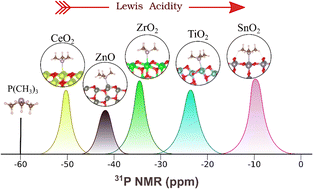Probing the nature of Lewis acid sites on oxide surfaces with 31P(CH3)3 NMR: a theoretical analysis†
Abstract
The characterization of catalytic oxide surfaces is often done by studying the properties of adsorbed probe molecules. The 31P NMR chemical shift of adsorbed trimethylphosphine, P(CH3)3 or TMP, has been used to identify the presence of different facets in oxide nanocrystals and to study the acid–base properties of the adsorption sites. The NMR studies are often complemented by DFT calculations to provide additional information on TMP adsorption mode, bond strength, etc. So far, however, no systematic study has been undertaken in order to compare on the same footing the chemical shifts and the adsorption properties of TMP on different oxide surfaces. In this work we report the results of DFT+D (D = dispersion) calculations on the adsorption of TMP on the following oxide surfaces: anatase TiO2(101) and (001), rutile TiO2(110), tetragonal ZrO2(101), stepped ZrO2(134) and (145) surfaces, rutile SnO2(110), (101) and (100), wurtzite ZnO(10![[1 with combining macron]](https://www.rsc.org/images/entities/char_0031_0304.gif) 0), and cubic CeO2(111) and (110). Beside the stoichiometric surfaces, also reduced oxides have been considered creating O vacancies in various sites. TMP has been adsorbed on top of variously coordinated Lewis acid cation sites, with the aim to identify, also with the support of machine learning algorithms, trends or patterns that can help to correlate the 31P chemical shift with physico-chemical properties of the oxide surfaces such as adsorption energy, Bader charges, cation–P distance, work function, etc. Some simple correlation can be found within the same oxide between the 31P chemical shift and the adsorption energy, while when the full set of data is considered the only correlation found is with the net charge on the TMP molecule, a descriptor of the acid strength of the adsorption site.
0), and cubic CeO2(111) and (110). Beside the stoichiometric surfaces, also reduced oxides have been considered creating O vacancies in various sites. TMP has been adsorbed on top of variously coordinated Lewis acid cation sites, with the aim to identify, also with the support of machine learning algorithms, trends or patterns that can help to correlate the 31P chemical shift with physico-chemical properties of the oxide surfaces such as adsorption energy, Bader charges, cation–P distance, work function, etc. Some simple correlation can be found within the same oxide between the 31P chemical shift and the adsorption energy, while when the full set of data is considered the only correlation found is with the net charge on the TMP molecule, a descriptor of the acid strength of the adsorption site.

- This article is part of the themed collections: Computational Modelling as a Tool in Catalytic Science and 2022 PCCP HOT Articles


 Please wait while we load your content...
Please wait while we load your content...